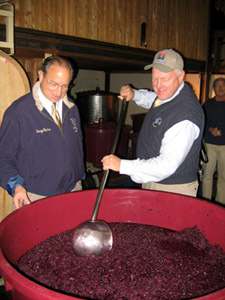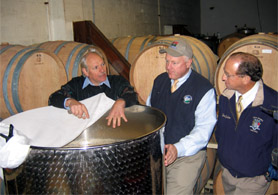NEW JERSEY FARMERS HARVESTING A NEW CROP OF WINE
Wineries Gearing Up to Compete in National, International Markets
For Immediate Release: October 25, 2007Contact: Lynne Richmond
(609) 633-2954
(TRENTON) – With more than 25 wineries in the state, some of which are producing wines that are gaining state, national and international recognition, New Jersey Secretary of Agriculture Charles M. Kuperus today proclaimed New Jersey an up and coming wine region that could someday be as well known as Sonoma and Napa in California.
Kuperus today visited Amalthea Cellars, a winery that has been producing wines with its own grapes and those of other local growers for a quarter of a century, where owner Louis Caracciolo demonstrated how his grapes are crushed on their way to becoming wine.
 “New Jerseywineries provide many agritourism opportunities, whether it is for wine-tastings, tours or festivals,” said Secretary Kuperus. “But, now we are seeing that the wines they produce are gaining in popularity. The Department of Agriculture is working with the wine industry to increase New Jersey grape production and assist wine growers in promotion of their product.”
“New Jerseywineries provide many agritourism opportunities, whether it is for wine-tastings, tours or festivals,” said Secretary Kuperus. “But, now we are seeing that the wines they produce are gaining in popularity. The Department of Agriculture is working with the wine industry to increase New Jersey grape production and assist wine growers in promotion of their product.”Assemblyman Douglas Fisher and Secretary Kuperus assist in the wine-making process at Amalthea Cellars
Amalthea is located in the largest wine-making region in the state, the Outer Coastal Plain, which was federally designated as an American Viticultural Area last March. The Outer Coastal Plain encompasses all of south Jersey. There are two other designated viticultural regions in New Jersey: Warren Hills in Warren County and Central Delaware Valley, which encompasses portions of Pennsylvania and central Jersey.
Jim Quarella, President of the Garden State Wine Growers Association, noted that the Outer Coastal Plain is known for its microclimate, with sandy, well-drained deep soils, milder winters and a good deal of sunshine, comparable to Bordeaux and Burgundy in France.
“With growing conditions typical of some of the finest wine regions in Europe, food friendly New Jerseywines are well on their way to being well-known and well-respected,” said Quarella. “Our wines satisfy a growing interest among New Jersey residents for quality locally-grown and produced products.”
Quarella is owner of Bellview Winery in Landisville, which also is located in the Outer Coastal Plain. Quarella is a fourth generation farmer who completed a conversion from a traditional vegetable farm and began making wine full-time in 2003.
“We are seeing a movement of some fruit and vegetable producers to wine makers, taking advantage of the ideal growing conditions for wine grapes in our state,” said Kuperus. “Wine is an important and growing segment of New Jersey agriculture.”
The wine industry is one of the Department’s economic development strategies, which calls for the support of the industry at trade shows, expansion of the annual Jersey Fresh Wine Festival to include producers of Jersey Fresh and Jersey Seafood products and the offerings of local restaurants that feature Jersey Fresh items, and support of the industry’s efforts to expand the number of retail outlets and their ability to sell their wine at farmers’ markets.
The Department and the New Jersey Wine Industry Advisory Council also recently made available applications on-line for New Jersey Wine Industry Project Grants. These grants are available to anyone who wishes to undertakewine industry projects to address research, development and promotion of the New Jersey wine industry. More information is available at www.nj.gov/agriculture/grants/wineindustrygrants.html.
In 2005, the Department expanded its Jersey Fresh standards to include New Jersey wines made from fruit grown in the Garden State. To be included in the voluntary program, the wine products must score at least a 13 out of 20 in the Quality Wine Alliance program (QWA). The New Jersey QWA program was started in 1999 and is based on a 20-point wine evaluation scale that was developed at the University of California-Davis. This evaluation scale gives points for appearance, color, aroma and bouquet, acesence, total acid, sugar, body, flavor, astringency and general quality. Wines that meet or exceed the rigorous review process are awarded the QWA designation
New Jerseywines are a $30 million industry annually. In 2006 there were 245,789 taxable gallons reported sold by wine growers in the state. New Jersey is the 5th largest wine producer in the nation, with 40 different varieties made by the state’s wineries.
For more information on New Jersey wineries, visit www.state.nj.us/jerseyfresh/wine.htm or the Garden State Wine Growers Association website at www.newjerseywines.com.



